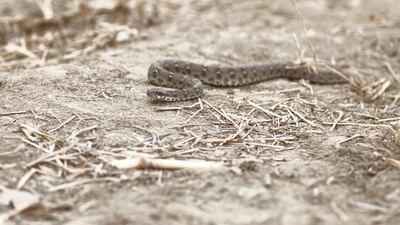With its intricate pattern of brown, cream and black scales, the saw-scaled viper is one of the UAE's most attractive animals.
Good looks hide an ugly nature, though, because the creature, which is typically only about 50-60cm long, is one of the world's most deadly snakes because of its aggressive nature.
Named after the frightening saw-like sound it makes by rubbing its scales over one another, it is responsible for a sizeable proportion of the tens of thousands of snakebite deaths in India each year.
But new research on saw-scaled vipers in the UAE shows that even fangs, venom and a bad temper cannot protect against an all-too-common affliction of wild animals: parasites.
A study found that the snakes – the locally found subspecies of which has the scientific name Echis carinatus sochureki – can be infected with a species of tapeworm not found in any other reptiles.
In a paper in the International Journal for Parasitology: Parasites and Wildlife, scientists named the newly identified tapeworm Ophiotaenia echidis in recognition of its host.
Dr Tomas Scholz, an author of the new research, said parasites were often highly specialised in the animals they infected, because they have evolved ways to get around hazards such as their host's immune response and conditions in the stomach.
"Imagine the stomach – it's a melting pot. There are digestive enzymes and it's very acidic," said Dr Scholz, who works at the Institute of Parasitology of the Biology Centre at the Czech Academy of Sciences.
"What would happen unless you're really well adapted? You need to inhibit these digestive enzymes to not become food."

The research was based mostly on analysing tapeworms in snakes sent to Dubai's Central Veterinary Research Laboratory (CVRL) after the animals were killed on farms or construction sites.
"Workers on the farm do not know which snakes are dangerous and which are harmless, they come from countries where snakes are dangerous I believe, and for this reason they kill them to be on the safe side," said Dr Rolf Schuster of the CVRL, another of the study's authors.
Dr Schuster discovered tapeworms in the snakes' intestines a number of years ago, but only in the new study were the parasites been identified and named.
Of 20 snakes Dr Schuster examined, six contained the tapeworms, with between four and 21 found per snake. Samples were sent to Dr Scholz and other researchers to identify.
The new species is characterised by anatomical features such as the arrangement of testes in two longitudinal rows.

Postmortem examinations on dozens of snakes from other species failed to show up the tapeworms, leading researchers to conclude the parasite infects only the saw-scaled viper.
The tapeworms can be 275mm long – half as long as the snakes they inhabit – but are not thought to cause significant harm unless the host is ill or otherwise stressed, perhaps because of a lack of food.
Some other snake tapeworms have two life-cycle stages in which they inhabit intermediate hosts such as tiny aquatic crustaceans called copepods before infecting fish or amphibians.
When the snakes eat the fish or amphibians, they become the definitive host, in which the tapeworm matures sexually. Because the UAE’s saw-scaled vipers live in the desert, there must be a different life cycle.
"It's really a big challenge for us to know how these life cycles are completed," Dr Scholz said. "To study life cycles, it's difficult, especially in the laboratory."
It is likely the snakes ingest larval forms of the tapeworms in their food, which includes scorpions and insects, such as locusts, which could be an intermediate host.
While the saw-scaled viper is blamed for many deaths in other countries, it poses little threat to UAE residents because encounters are rare. Experts say there have been just a handful of deaths from snake bite in the country over several decades.
“These snakes are active in summer, when people avoid going to the desert, and hide during the winter months, when people do camp in the desert,” Dr Schuster said.
"Snakes that I kept stopped eating in November and fasted until end of March. For this reason, contact between people and snakes is limited."
The other authors of the study are Dr Alain de Chambrier, of the Natural History Museum in Geneva, and Dr Philippe Alves, of Brazil's Federal University of Minas Gerais.













